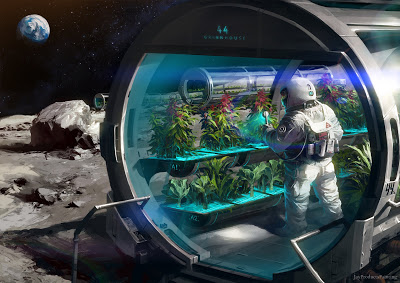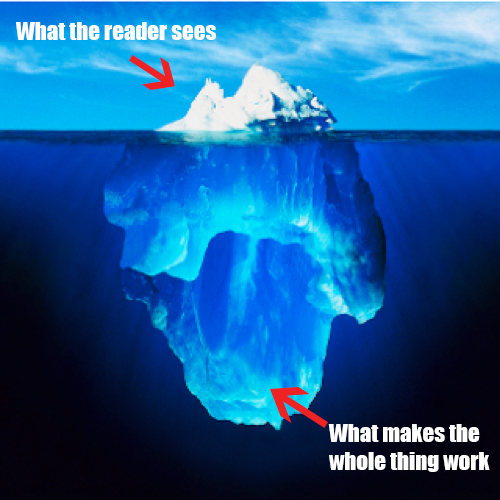There’s a common thread running through my work, I can see it now, I’m not sure if it’s a good thing or not. I write a lot about farms in space, maybe there’s a subliminal thing about food or perhaps it’s to do with my Devon heritage and ancestors background in farming. I have farms all over the place, on airless planets under domes, on space stations and in tunnels.
It all started in Ribbonworld, with a farm supplying the needs of the population of the planet Reevis. I could see the need for the place to have its own food growing facilities; it would be a logistical nightmare to keep everyone fed otherwise. The planet having no atmosphere wasn’t really an obstacle, I just put up another dome and there it was.
I then realised that the farm could have another use. I could use it to introduce tension, by making it independent of the company that mined and owned the planet. The two factions needed each other but resented the arrangement as well. Then there was the stigma attached to imports against “Dome-made,” a rather catchy term I invented. It made a few good plot twists possible, a safe place for people to disappear to, all that sort of thing.
And then I had another idea, if I could put a farm under a dome, why not put one on a space station? It would save room on overcrowded Earth, reduce methane emissions and again, provide tension. For example, what if the supply of produce back to Earth failed, would people go hungry? Could the farmers hold the planet to ransom? The result was a short story, “The Orbital Livestock Company,” which is now being extended into a novel, where that sort of thing happens.
The next logical step was to have farms popping up all over the Galaxy! Anywhere that wasn’t Earth in fact. Space travellers have to eat and what’s better than fresh food? It’s a link to home, you don’t have to worry about alien pathogens. And they all have more than one function. Taking what I learned from Ribbonworld and applying it, the space station located off Saturn in Andorra Pett and the Oort Cloud Café has a farm, the owner provides romantic interest and it all adds to the setting. The company also owns a farm on Mars, in an airtight cave, which features in Andorra Pett on Mars. It’s likely that they will open branches everywhere, as long as they can provide an extra dimension to the plot of whatever they appear in.
I’m developing the idea of farming on alien worlds as well. Once you start creating, it becomes hard to stop, as each thing you describe brings more questions and needs research to justify it. The farmers on Ecias (in my soon-to-be-released novel Life and other Dreams), for instance, are careful not to let the Earth species contaminate the planet, at least until it becomes unavoidable. So they keep the livestock in cages until they have figured out the way the alien food-chain and animal DNA will react to this invasion. And no doubt, they would have to isolate the soil to stop the spread of contaminants through fungal networks, or whatever the alien equivalent is.
That’s all well and good where you have soil that supports the cultivation of plants from Earth. That’s the basis for my construction of the off-world farms. I just adapt the technology and structure of it to fit in with my new environment. Obviously, on a space station the soil is imported, on a planet like Mars or even Reevis, the native soil will be dead and need activation, perhaps by human or animal waste. It may contain anaerobic bacteria I guess, that’s a matter for the world builder in me to determine.
Talking of world building, perhaps you can see the fascination that I get from trying to make everything believable, once you have an idea you need to understand it and be able to stretch the truth a little, to make it all fit together. In a way, I find that just as enjoyable as writing the plot, the setting becomes another character, with its own emotions and a part to play. And basing everything in fact gives you the opportunity to invent the setting in every logical detail.
Before it all goes down on paper, there are a lot of things to organise, facts to verify and continuity to establish. The more you write, especially in the same series of books, the more there is to check, to make sure that you haven’t contradicted yourself.
In separate universes, it’s OK to do things differently, but if there is the danger of your worlds overlapping at some stage then it all has to work together. I once had to do an enormous rewrite to one of my books, because when I had finished it and read it back, I found that the plot was inconsistent with the others in the series. Someone was reminiscing about an event that hadn’t taken place in the way they were now describing it. As it was crucial to the plot, it caused me a lot of trouble.
Which leads us to my upcoming course in World Building. I’ve been presenting my ideas and methods as a workshop at various literary events, the general opinion has been that it deserves a wider audience. So I’m currently turning it into an online course, with video lectures, downloadable information and suggested exercises. I wanted to get it finished last year but life got in the way. Now I will just be happy when it’s done.
Next week, I will be reporting on my attendance at Devcon Exeter, where I am hoping to sell lots of books and short stories. If you’re in Exeter on Feb 4th come to the Corn Exchange and say hello.
![]()




